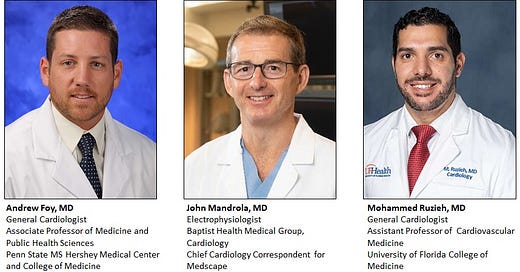Cardiology Trial’s Substack will publish reviews from our upcoming textbook of clinical trials in cardiovascular medicine. We chose these trials because they have had a major impact on how the field is practiced.
The trials are indexed according to major subject headings and will be presented in chronological order by publication date. But this is more than just a stroll through medical history and recital of study abstracts. The authors appraise each trial (over 200 and counting!) with a focus on its clinical translation for modern day practice. A distinguishing feature of this work is the emphasis placed on evaluating and understanding the external validity of each trial and its results.
The authors (Andrew Foy, John Mandrola, and Mohammed Ruzieh) are practicing cardiologists, first and foremost, who place a high value on education and scholarship. The intended audience is medical trainees and professionals of all levels as well as lay readers who are interested in understanding how medical evidence, of the highest level, is generated and where recommendations from their physicians come from. It is especially useful for medical trainees rotating through cardiology services.
The major subjects are arranged as follows:
1. Prevention
1a. Primary
1ai. Hypertension
1aii. Lipid lowering
1aiii. Antiplatelet
1aiv. Glucose lowering
1av. Diet/weight loss
1avi. Miscellaneous
1b. Secondary
1bi. Lipid lowering
2. Stable coronary artery disease
2a. Diagnostic
2b. Therapeutic
2bi. Medicines
2bii. Interventions
3. Acute coronary syndrome
3a. Medicines
3b. Interventions
4. Congestive heart failure
4a. Systolic
4ai. Medicines
4aii. Interventions/devices
4b. Diastolic
4bi. Medicines
4bii. Interventions/devices
4c. Mixed
4ci. Medicines
4cii. Interventions/devices
5. Arrhythmias
5a. Atrial
5ai. Medicines
5aii. Interventions
5b. Ventricular
6. Valvular heart disease
6a. Aortic
6b. Mitral
6c. Tricuspid
6d. Mixed
7. Special topics
7a. Screening/population health
7b. Pericarditis
7c. Cardiac arrest
7d. Cardiogenic shock
7e. Cardio-oncology
7f. Vascular disease
7g. Perioperative medicine
Each review is formatted as follows:
Background
Patients
Baseline characteristics
Procedures
Endpoints
Results
Conclusions
Patients
After background we start with patients. This may seem an odd choice but was deliberate. In a typical clinical trial manuscript, the baseline characteristics of participants are usually presented in the first paragraph of the results and as a table. In our experience, they tend to be glossed over by readers; however, the most important aspects for clinical translation reside in these details.
How were these patients chosen and who are they, exactly? This knowledge is critical to applying trial results in the clinic. The first step for a clinician is to estimate how close our patient is to the average trial participant. Factors such as place of enrollment in the trial (hospital or outpatient clinic), condition at time of enrollment (acutely ill or stable), age and other co-morbid conditions are critical to consider when translating evidence to patient care.
The Procedures and Endpoints
How was the intervention carried out and how were patients managed?
When you think of using this intervention in clinical practice, would it be done in a similar manner? For example: starting dose, target dose, dose-titration and stopping rules, frequency of follow-up visits, lab draws, etc. Is the manner in which it was carried out in the trial practical or not for you and your patients?
After procedures comes a brief review of endpoints and important statistical considerations, if present. We will do our best not to belabor statistical issues. What we care about is simple: the primary endpoint of the trial and whether investigators made efforts to recruit an adequate sample size to test the hypothesis appropriately in regard to the primary endpoint. When the answer to this is yes, which it is on most occasions, we may not present details of sample size calculations in an effort to streamline writing. When it is not, we will address it.
Lastly, are the main results followed by our conclusions. We will limit our presentation of results to the primary endpoint and what we consider the most important secondary endpoints, if present, as well as safety endpoints.
Subgroups
Efforts will be made to highlight subgroup results important for clinical translation while acknowledging the important limitations of such analyses (e.g., low statistical power leading to false positive and false negative results). The challenge with subgroups: whenever we compare subgroups (say, diabetes or no diabetes) we compare smaller groups. This increases the chance that a signal is actually noise.
Since clinical trial results apply to populations, when it comes to managing individual patients, it’s ideal to get as close to a representative population of patients as possible, which might only be found in a subgroup analysis. When such analyses provide evidence of treatment response variation that is reasonable from a theoretical perspective, we will highlight it and discuss how it influences our overall conclusions.
Conclusions
In the conclusions, we will emphasize absolute risk differences and number needed to treat or harm estimates. While relative differences are important, they may be deceptive for providers as well as patients when used in isolation. We also discuss how the trial results and procedures compare to other trials.
In a coming second introductory post, we will discuss the principle of external vs internal validity.





Looking forward to this.
I was always taught that the methods section of a paper is the most important one. Glad you will be highlighting the concept of “do these study subjects look like my patients”. And I’m strictly a ARR and NNT person. Relative risk is relatively meaningless in my book (since it is a useless metric in isolation and requires the context of baseline risk….but once you consider RRR and baseline risk in combo…as you should….that’s ARR).